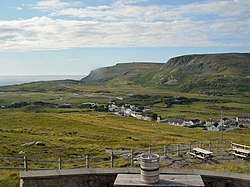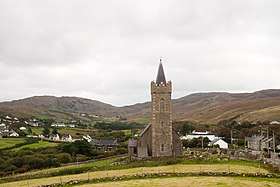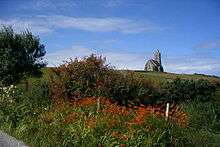Glencolmcille
Gleann Cholm Cille (anglicised as Glencolumbkille or Glencolmcille)[2] is a coastal district in the southwest Gaeltacht of County Donegal, Ireland. It is also a civil parish in the historic barony of Banagh.[3]
Gleann Cholm Cille | |
|---|---|
Civil parish | |
 View of Glencolmcille | |
 Gleann Cholm Cille Location in Ireland | |
| Coordinates: 54°42′32″N 8°43′34″W | |
| Country | Ireland |
| Province | Ulster |
| County | County Donegal |
| Elevation | 20 m (70 ft) |
| Population (2016)[1] | 217 |
| Irish Grid Reference | G529846 |
| Gleann Cholm Cille is the only official name. The anglicised spellings Glencolumbkille and Glencolmcille no longer have any official status. | |
While Gleann Cholm Cille is still an Irish-speaking community, English has been steadily replacing Irish as the main language, with only 34% of the people speaking Irish on a daily basis in 2002.[4] Cashel (Irish: An Caiseal) is the main village in the district.
The name translates into English as "valley of Colm Cille". Saint Colm Cille, or Columba, is one of Ireland's three patron saints (along with Saint Patrick and Saint Brigid). Colm Cille and his followers lived in the valley for a time and the ruins of several of their churches can still be seen there.
History
Between 4000 and 3000 B.C., farming people settled in the area.
The district was once famous as being the parish of The V. Rev. James Canon McDyer (1910–1987), who championed the rights of rural people and helped establish community-based industries in the area. A parish council (Comhairle Paróiste Ghleann Cholm Cille) has been functioning in Glencolumbkille since the 1930s, to look after the interests and needs of the residents of Glencolumbkille. Members are elected to this body by the residents of the Glencolumbkille church area; elections are held every three years.
Historic sites
Four sites make up National Monument #139:

- Glencolumbkille Cashel (54.708756°N 8.722247°W) — A penitential station, also called Glencolumbkille Turas (Irish for "journey"). Every 9 June the local people go through 15 "stations." It begins at a court cairn, constructed 3000 BC. The pilgrim circles the cairn three times praying, places his/her back to the stone, then renounce the World, the Flesh, and the Devil.[5]
- Glencolumbkille Church (54.718464°N 8.736631°W) — A holy well is located in Beefan townland.[6]
- Malin Beg (54.665009°N 8.770639°W) — Church of St Kevin and ringfort.
- Malin More (54.682566°N 8.720830°W) — A portal tomb dated to c. 2000 BC.[7]
Culture
Glencolumbkille was home to the Dublin-born artist Kenneth King, whose works depict naval and merchant shipping, coastline and lighthouses.[note 1]
British composer Sir Arnold Bax made many extended visits there between 1904 and the early 1930s. Apparently, Bax composed much of his music and wrote many of his poems and stories while staying there. He describes the district and its villages, and the life of its inhabitants, in his autobiography Farewell My Youth.
At one end of the little Glen Bay was a wilderness of tumbled black rocks, for some reason named Romantia (a particularly "gentle" – or fairy-haunted place, I was told in Dooey opposite), and upon this grim escarpment the breakers thundered and crashed, flinging up, as from a volcano, towering clouds of dazzling foam which would be hurled inland by the gale to put out the fires in the cottage hearths of Beefan and Garbhros. The savagery of the sea was at times nearly incredible. I have seen a continuous volume of foam sucked, as in a funnel, up the whole six-hundred-foot face of Glen Head, whilst with the wind north-west a like marvel would be visible on the opposite cliff.
There were days when you had to lean hard up against the wind to keep your feet at all... Yet in that unearthly valley there always seemed to be a core of peace in the heart of the most ravening tempest.
—Arnold Bax, Farewell My Youth
There are a number of natural sites nearby, such as the Slieve League (Irish: Sliabh Liag) cliffs, The Silver Strand (Irish: An Tráigh Bhán) at Malin Beg (Irish: Málainn Bhig), and Glen Head (Irish: Cionn Ghlinne) itself.
At the centre of one of the largest Gaeltacht areas, the district is known as the home of Oideas Gael, an Irish-language learning institute established in 1984 to promote the Irish language and culture. The district also has a petrol station, grocer, post office, folk village, woolen mill, hill walking and accommodation centre, restaurant, "village cafe" and two pubs (often with Irish fiddle music).
Films shot on location in Glencolumbkille include The Railway Station Man, 1992, starring Julie Christie, Donald Sutherland and John Lynch.[8]
Notable people
- John Joe Doherty, Gaelic footballer
- Noel Hegarty, Gaelic footballer
- Patrick (Sonny) McGinley, novelist
- Charles Inglis, first Bishop of Nova Scotia, was the son of a Church of Ireland rector of Glencolumbkille.
- James Canon McDyer, was born in Glenties close to Glencolmcille.
Gallery
 Typical local cottage at the Folk Village Museum.
Typical local cottage at the Folk Village Museum. Folk Village Museum historical cottages.
Folk Village Museum historical cottages. Trabane Strand, Glencolumbkille.
Trabane Strand, Glencolumbkille.- Kenneth King, outside Straid Studio-Gallery
 Church of Ireland church at Glencolumbkille. Henry Musgrave had the tower built in 1913.[9]
Church of Ireland church at Glencolumbkille. Henry Musgrave had the tower built in 1913.[9]
Footnotes
- Some of Kenneth King's paintings are on display in the National Maritime Museum of Ireland in Dún Laoghaire
References
- "Census 2016 Sapmap Area: Settlements Gleann Cholm Cille". Central Statistics Office (Ireland). Retrieved 4 June 2018.
- Placenames (Ceantair Ghaeltachta) Order 2004, Commissioner.ie
- "Glencolumbkille". IreAtlas Townlands Database. Retrieved 6 May 2015.
- Glencolmcille Parish Plan Archived 2007-11-18 at the Wayback Machine.
- "Glencolumbkille Station 1". Megalithicireland.com. Retrieved 27 July 2019.
- "Historic Glencolmcille". Gleanncholmcille.ie. Retrieved 27 July 2019.
- "Malin More Portal Tombs and Standing Stone". Megalithicireland.com. Retrieved 27 July 2019.
- Glencolmcille on IMDb
- "Photograph of the inscription on the church tower, Glencolumbkille". Flickr.com. Retrieved 27 July 2019.
